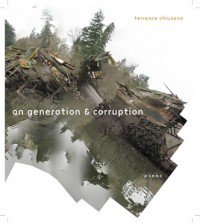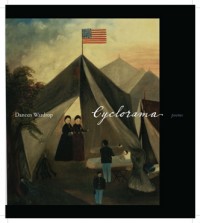

on generation and corruption
by Terrence Chiusano
Cyclorama
by Daneen Wardrop
Fordham University Press, 2015
About a decade ago ‘trauma’ became an industry in the academic literary critical economy. This was due in part to the success of Cathy Caruth, but there were other theorists that mattered before and after (Freud’s ‘repetition compulsion’ and Elaine Scarry’s body in pain). Holding hands with trauma was ‘witness’. Of course, witnessing has been in the discourse for a long time as well, but there was a steady growth in its paradigmatic quality after the Holocaust industry began to develop more fully (see Norman Finkelstein). The two publications under review here – Terrence Chiusano’s on generation and corruption and Daneen Wardrop’s Cyclorama – brought to mind trauma and witness, albeit in very different ways. What they struggle with, narrate, explain, uncover, unpack, engage, develop is not simply History but a set of language games with micro and macro focus on ‘the past’. Although this is more obviously the case in Cyclorama, it is there in Chiusano’s work too.
As X states in her introduction ‘In Cyclorama, Wardrop gives us a collection of persona poems, voices from the American Civil War.’ (vii) We are in Drum Taps country in other words. This is not the poetic re-imagination of the past in, say, the same way as Charles Olson. Olson, the 6 ft 8 inch bear of a man, projected H history onto his minor place – Gloucester. This is the inverse – the re-insertion of small moments into Historic events, like a poetic Carlo Ginzburg. This is eating, sweating, clothing, bleeding of the local. At the level of form though the line is not breath but is a long page limited unit that is a complete thought or image. Only when line, or more likely paragraph, breaks do we end this particular thing.
The tone throughout is simple, matter of fact, but not without warmth, personal details or homeyness. This is inhabiting the voices of particular historical actors so as to create emotional resonance between reader, author and past subject. Wardrop has a consistent tone. Generally this is a quality lauded by poets and critics but here it undermines the attempt to historicise the multiplicity of the event. If form is never more than an extension of content, style must enter into it as well, especially for the work to appeal. This is to say that something here is somewhat confused even as there is beauty magnitude, proportion and scale. This is seen in ‘Home From The War’:
This is where we welcome you home again,
same season, same 1861, same roses in bloom,
the fighting over
fast as wishing.
Inside the picture, though, I know years of seasons
when hands smoothed napkins,
children passed around bread, cheese reconnoitred with the rennet.
I’ve studied the apple and pear for you, the curtain folds.
I have worn my body.
Our child uses my hand to wave at a neighbour.
Nightwind shapes itself to the keyhole, enters.
The faithful whalebone corset still presses skin.
Our time is dividual
as yours, forgetting the cut-ching of bullet, grape and canister, the red moue of cannon.
And so, your sword has been erased now in this picture
and so I ask, will an embrace be able to relove its arms – (8)
The technique of repetition – ‘same’, ‘same’, ‘same’ and ‘and so’ – comes again in ‘Home From the War: Officers’ Edition’ and ‘The War Spirit at Home’. Also it is typical in terms of having a solid I. Of course that I has been destabilised by the war experience, but it is not fragmented in its subjectivity at the level of form. It tells us that it has been fragmented. This occurs throughout the volume, it is an I of witness and experience, of being in war as a participant observer. This is only rarely absent (for example ‘Army of the Cumberland Panel’). The strongest section of Cyclorama is ‘A Pin-Star Starts’ which are poems about panels. Throughout though Wardrop uses historical sources – paintings, diaries and others – to great creative effect. It is only that the volume is diminished by the bland sameness of the I that speaks, actually collapsing radical distinctions between historical actors into a boring, if somewhat lyric, middle ground.
By contrast, the I is all but absent in Chiusano’s on generation and corruption. The sections that seem most connected to the historical are those that are dates and formed as diary entries. Part of ‘July 6’ reads:
A hum, a nod, a dodgeball, maypole, sugarplum, the lever of the merry-go-round, mound of mildewed stove-wood, Dear John Letter, can of rusty finishing nails… whatever
It is a list poem, but also describes a domestic scene with elan, made possible through rhyme (round/mound, letter/whatever) and precision (mildewed, rusty). ‘July 7’ reads in entirety:
Dusk. Crows. Dirt road. Crack of a distant rifle.
We could well be in the Civil War of Cylcorama, but we must piece that together ourselves.
There are, of course, other sections and other voices in on generation and corruption. Page 35 plays in a Steinian register, by listing, almost like Goldsmith’s Fidget, a range of bodily movements. There is though a return to narrative and a strong sense of forward movement. And that may be where there is concurrence with Wardorp. All in all though it is a mildly challenging and enjoyable read (particularly the abecedarian section).
These two books published both by Fordham University Press are a welcome addition to the discourses about time, the past and present. They overlap with ideas of memory, experience, historicisation and enable us to think through primary aesthetic concerns in an altogether exciting, if not quite demanding, way. I would recommend them particularly for people with an interest in war and its narration and the daily life of contemporary America.













